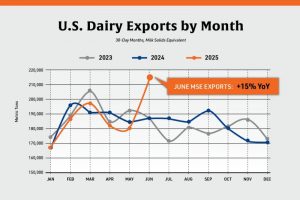
Despite record exports, global trade tensions threaten key dairy markets and long-term industry stability.
The U.S. dairy sector is outperforming amid a troubling overall agricultural trade picture, with exports exceeding $3 billion through April and outpacing imports by more than $1 billion. In contrast to a record-setting $20 billion U.S. ag trade deficit for the first four months of the year, dairy exports are a rare bright spot. Yet, this growth is threatened by unresolved global trade tensions, making foreign-market access both a profitability driver and a major risk factor for the industry.
Key dairy export destinations remain concentrated, with 74% of export value going to just 10 markets. Mexico, Canada, and China account for more than half, underscoring the sector’s vulnerability to political tensions and shifting tariffs. Mexico continues to be the top buyer, representing nearly one-third of U.S. dairy exports. These trade relationships are essential, yet increasingly volatile, as policy shifts in Washington and abroad could jeopardize established flows.
U.S. dairy exports are dominated by shelf-stable products like cheese, nonfat dry milk, and powdered ingredients, which are more cost-effective to transport than fluid milk. Cheese alone contributed over $2.4 billion in export value in 2024, followed closely by nonfat dry milk and “other dairy products” like lactose and milk-protein concentrates. These coproducts of domestic cheese processing play a vital role in maximizing value and sustainability within the supply chain.
Despite increasing domestic demand for dairy-based foods, long-term declines in fluid milk consumption drive the need for exports. Production per cow has surged nearly sixfold since 1924, reaching over 24,000 pounds annually. This productivity, along with stagnant domestic demand for fluid milk, reinforces the necessity of strong export channels to absorb surplus output—especially in powder and whey segments, where 70–85% is shipped overseas.
However, this dependency brings exposure to shifting global trade dynamics. U.S. dairy exports face roadblocks in Canada due to protectionist quota allocations, while Mexico, though a strong market, saw diplomatic backlash following new U.S. tariffs. With 1 in 6 gallons of milk exported, and much of it as coproducts that rely on global markets, maintaining and defending trade access is vital for the economic future of American dairy.
Source: Agri-View – AgUpdate.com
You can now read the most important #news on #eDairyNews #Whatsapp channels!!!
🇺🇸 eDairy News INGLÊS: https://whatsapp.com/channel/0029VaKsjzGDTkJyIN6hcP1K























